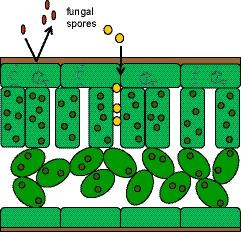Our official English website, www.x-mol.net, welcomes your
feedback! (Note: you will need to create a separate account there.)
Leaf resistance traits influence endophytic fungi colonization and community composition in a South American temperate rainforest
Journal of Ecology ( IF 5.3 ) Pub Date : 2019-11-25 , DOI: 10.1111/1365-2745.13314 Marcia González‐Teuber 1 , Claudia Vilo 2 , María José Guevara‐Araya 1 , Cristian Salgado‐Luarte 3 , Ernesto Gianoli 3, 4
中文翻译:

叶片抗性性状影响南美温带雨林中内生真菌的定殖和群落组成
更新日期:2019-11-25
Journal of Ecology ( IF 5.3 ) Pub Date : 2019-11-25 , DOI: 10.1111/1365-2745.13314 Marcia González‐Teuber 1 , Claudia Vilo 2 , María José Guevara‐Araya 1 , Cristian Salgado‐Luarte 3 , Ernesto Gianoli 3, 4
Affiliation

|
- Despite the ubiquitous presence of fungal endophytes in woody plants, mechanisms underlying variation in foliar fungal endophyte communities are poorly understood. Given that endophytes in woody plants are predominantly horizontally transmitted, fungal endophyte colonization of foliar tissues is likely to be influenced by plant resistance traits. Here, we evaluated the association between leaf resistance traits and colonization and community composition of horizontally transmitted endophytes (HTE) in 10 dominant trees species in a temperate rainforest in Southern Chile. Because resistance traits might restrict colonization of HTE, it was hypothesized that host trees with similar leaf resistance traits would show similar HTE communities.
- We measured leaf traits with reported roles in plant resistance against pathogens and/or herbivores: cell wall polysaccharides, leaf toughness, flavonoids, anthocyanins, terpenoids and chitinases. We also determined variation in fungal read counts, number of operational taxonomic units (OTUs), diversity and community structure across tree species. Foliar fungal endophyte communities were characterized using Illumina MiSeq sequencing of tagged amplicons of the ITS1 region.
- Fungal read counts were significantly different among host trees, while number of OTUs and diversity were similar among them. Multivariate analyses showed that community composition of endophytic fungi significantly differed among hosts, and that variation in cell wall, flavonoids, anthocyanins and terpenoids was associated with differences in HTE communities. We found that host trees sharing leaf resistance traits harbour similar HTE communities. Fungal read counts decreased with increasing content of cell wall polysaccharides, while endophyte diversity decreased with increasing anthocyanin levels. Fungal read counts, in contrast, were positively associated with terpenoids. Additionally, culture‐based data indicated that some HTE strains inhibited the growth of the common fungal pathogen Botrytis cinerea.
- Synthesis. Overall, we found that leaf resistance traits may influence fungal endophyte colonization and community composition in tree species, likely through deterrent effects of structural and chemical traits. We suggest that endophytic fungi that overcome resistance traits might play a role in plant protection.
中文翻译:

叶片抗性性状影响南美温带雨林中内生真菌的定殖和群落组成
- 尽管木本植物中普遍存在真菌内生菌,但对叶内真菌内生菌群落变异的潜在机制了解甚少。考虑到木本植物中的内生菌主要水平传播,叶组织的真菌内生菌定植很可能受到植物抗性性状的影响。在这里,我们评估了智利南部温带雨林中10种优势树种的叶片抗性性状与水平传播的内生菌(HTE)的定殖和群落组成之间的关联。由于抗性性状可能会限制HTE的定殖,因此假设具有相似叶片抗性性状的寄主树将显示相似的HTE群落。
- 我们测量了在植物对病原体和/或食草动物的抗性中所报告作用的叶片性状:细胞壁多糖,叶片韧性,类黄酮,花色苷,萜类和几丁质酶。我们还确定了真菌读取计数,可操作分类单位(OTU)的数量,树木物种间多样性和群落结构的变化。使用Illumina MiSeq测序技术对ITS1区域的带标记扩增子进行表征,以表征叶真菌内生菌群落。
- 宿主树之间的真菌读取计数显着不同,而它们之间的OTU数量和多样性却相似。多变量分析表明,宿主之间内生真菌的群落组成显着不同,并且细胞壁,类黄酮,花色苷和萜类化合物的变异与HTE群落的差异有关。我们发现具有抗叶性状的寄主树具有相似的HTE群落。真菌读取计数随着细胞壁多糖含量的增加而降低,而内生菌多样性随着花色苷水平的提高而降低。相比之下,真菌读取计数与萜类化合物呈正相关。此外,基于培养物的数据表明,某些HTE菌株抑制了常见真菌病原体灰葡萄孢的生长。
- 综合。总体而言,我们发现,叶片抗性性状可能通过结构和化学性状的威慑作用而影响树木中真菌内生菌的定殖和群落组成。我们建议克服耐药性状的内生真菌可能在植物保护中发挥作用。











































 京公网安备 11010802027423号
京公网安备 11010802027423号